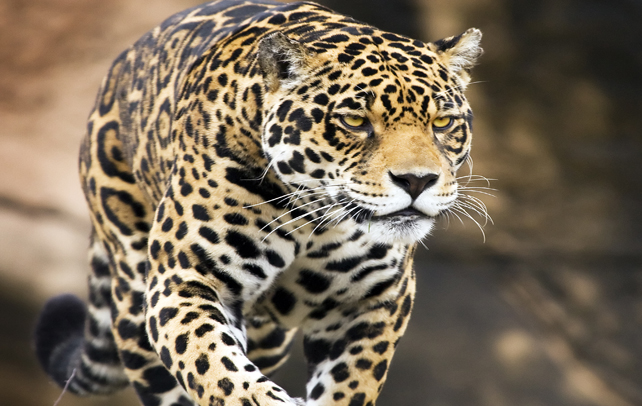Fun Facts About Jaguar

Best known to resemble leopard, a jaguar is larger and of muscular built and its behaviour is closer to that of a tiger. It has a solid body, big head, and powerful jaw. Its coat has a yellow and tan colour but colour can vary from reddish brown to black. The spots on its coat are more solid and black on the head and neck. They have larger rosette shaped patterns along the body which separates them from leopards. A short and burly structure makes them expert at climbing, crawling, and swimming skills. Jaguars have the strongest bite as they bite with a force of 2,000 pounds which kills the prey instantly and that is why it is able to pierce through armadillos and turtles. Jaguars fall under the category of near to extinction and their numbers are declining continuously. Constant hunting, forestry, and human habitation are the reasons of their decreasing numbers. Read the subsection below and collect some interesting and amazing facts about jaguar.
Fast Facts
Scientific Name: Panthera Onca
Kingdom: Animalia
Phylum: Chordata
Class: Mammalia
Order: Carnivora
Family: Felidae
Genus: Panthera
Species: Panthera Onca
Diet: Carnivorous
Size: Body: 1.2 m to 1.95 m; Tail: 45 to 75 cm
Weight: 56 to 160 kg
Teeth: 32 to 34
Life Span: Approximately 24 years
Natural Habitat: Rainforests, open terrain
Call: Roar
Gestation Period: 3 to 4 months
Number of Offspring: 2 to 4
Interesting And Fun Facts About Jaguar
- The word Jaguar has been derived from Native American word ‘yaguar’ which means ‘he who kills in one leap’.
- The beast has been called as el tigre in many south and central American countries.
- Argentina, Brazil, Bolivia, Belize, Costa Rica, Ecuador, French Guiana, Mexico, Colombia, Peru, Paraguay, Panama, United States, Gautemala, Guyana, Honduras, Venezuela, Suriname, and Nicaragua are the countries where one can find jaguars.
- The DNA tests have revealed that jaguars belong to the same ancestor as tiger, leopard, snow leopard, and clouded leopard.
- Panthera once augusta, one of the oldest species of jaguar, became extinct during the Pleistocene epoch, approximately 10.2 million years ago.
- They are the largest cats in Southern America and third largest in feline category with the recorded weight of 160 kg.
- Jaguars have rose-like markings or rosettes on their skin which help them camouflage in dense forests.
- These rosettes help in distinguishing jaguars from leopards. Jaguars have fewer, darker, larger rosettes with small spots at the centre, which the leopard lacks. Moreover, jaguars are sturdier and have shorter limbs.
- They are known for their power, beauty, strength, and an unusual menu.
- Strangely apart from big prey, they also hunt anacondas, monkeys, sloths, mice, birds, fishes, and pacas.
- Jaw and skull are the most robust parts of a jaguar’s body and that is why it is able to take down its prey in one pounce.
- With their short and sturdy physique, jaguars can hunt animals weighing 300 kg, which is almost double their own weight.
- Being a perfect swimmer, the jaguar can also dive into water to catch the prey.
- Unlike other felines, jaguar starts eating the prey from its neck and chest.
- Amazingly, instead of using deep-throat method, they bite with their canines located on the temporal bones of the skull which is the area between ears. They pierce their sharp canines inside the brain which quickly destroys the victim and does not give it a chance to save itself.
- Jaguars are very solitary animals who usually meet for mating only. But if a male stays even after the birth of the cubs, the female scares away the male. This type of behaviour is also showcased by tigress to avoid infanticide.
- There is typically no fight between jaguars but a clash may happen between powerful males over territory. A jaguar may allow females to overlap within its territory and consider them to mate with it only. It will shoo away any other male trying to approach the females.
- Jaguars mark their territories by clawing or leaving feces and urine. Male can cover 19 to 53 square miles while females protect 10 to 37 square miles. Males’ territories never overlap but females have overlapping territories.
- Cubs are born with their eyes closed and with furs on their body. They start seeing the world after two weeks of birth. They are weaned off after three months but they stay with their mothers till they are two year old.
- A study in 1939 suggested that there are eight subspecies of jaguar but a recent study revealed that they have only three subspecies.
- Like other cats, they don’t hate water instead they love it. They have been seen playing, hunting, and swimming in water. They can also climb trees to ambush the prey in one go.
- Jaguar has also been regarded with reverence in Mayan and Aztec cultures. Mayan people considered it god who helped in communication between dead and living, whereas Aztecs believed it to be a ruler or warrior.
- Jaguars are on the top of the food chain and cougars come next to them. They have no known predators except humans who consider them the killers of their farm animals.
- They are hunted for their fur, which is priceless.
- Jaguars that live in forests are darker and smaller as compared to those surviving in open areas.
- Macho-B, the oldest jaguar species, was recaptured on 2 March 2009, in southern Arizona. But it was later euthanized as it was suffering from kidney failure.
- Although most of the jaguars have spots on their skin but there are others with complete black or white skin due to colour morphism. Black ones are found in good numbers and are informally known as black panthers but the white ones, known as white panthers, are extremely rare.









